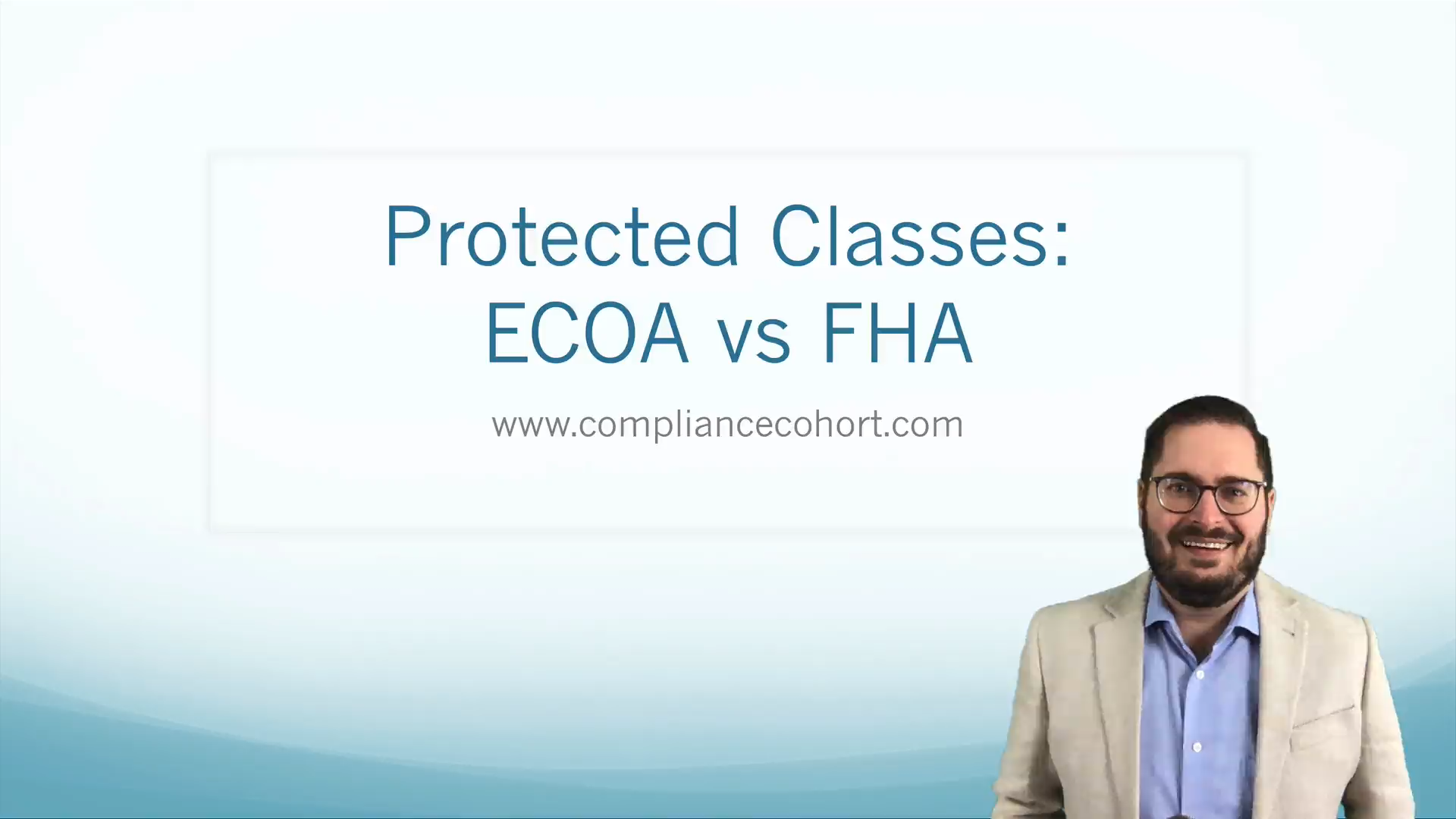VIDEO: Protected Classes - ECOA vs FHA
In this Compliance Clip (video), Adam explains the differences in who is a “protected class” under the Equal Credit Opportunity Act and the Fair Housing Act. This short training video is a fair lending topic.
Video Transcript
The following is a transcript of this video:
This Compliance Clip is going to talk about protected classes under both the Equal Credit Opportunity Act and the Fair Housing Act. These are two fair lending laws that were passed quite some time ago but they actually overlap when it comes to protected classes. The Fair Housing Act was passed in 1968. It has one set of protected class applicants while the Equal Credit Opportunity Act was passed in 1974 and that has a slightly different set of protected class applicants.
When I say protected class, it's important to understand when we talk about discrimination in lending, we are not allowed to discriminate against a protected class. We have to understand what a protected class is under both the Equal Credit Opportunity Act and the Fair Housing Act in order to ensure we don't discriminate. Again, both of these rules are slightly different, so there is some overlap, but let's take a look at both of these.
First, the Fair Housing Act. The Fair Housing Act prohibits discrimination against the protected class, which is the defined as somebody based on their race or color, national origin, religion, sex, familial status, which is defined as children under 18 living at home, or handicap. That is how a protected class applicant is defined under the Fair Housing Act. Of course, the Fair Housing Act covers fair housing and deals with loans for dwellings. That's what we're talking about in fair housing. The Equal Credit Opportunity Act is slightly different. What you see here is the protected class applicants for fair housing, but you'll see the non-bolded pieces, these are the pieces that actually overlap with the Equal Credit Opportunity Act. So the bolded pieces are unique to the Fair Housing Act and these, of course, include familial status and handicap.
When it comes to familial status, we cannot discriminate somebody based on how many children under 18 are living at home. If you have a show called 19 Kids and Counting, which would be the Duggar family, you cannot discriminate against them just because of how many kids they have under 18 living at home. You and I both know the kids are freaking expensive. They're really, really expensive, but we cannot discriminate based on the fact that they have kids living at home. That is one piece. The other piece of course, is handicap under the Fair Housing Act.
The Equal Credit Opportunity Act, again, was passed in 1974. This has a prohibition on discrimination against protected classes, which are defined as individuals based on race or color, religion, national origin and gender, just like we saw in the Fair Housing Act. But the Equal Credit Opportunity Act has a few other protected classes under its definition. These include marital status, age, receipt of public assistance, and a good faith exercise of rights under the Consumer Credit Protection Act. The first four, again, are an overlap with the Fair Housing Act, but the Equal Credit Opportunity Act goes above and beyond and looks at marital status. We cannot discriminate based on marital status under ECOA and Regulation B. We also cannot discriminate based on age under ECOA. The age of course, under regulation B, is age 62 and above would be elderly. That would be a problem. You cannot discriminate against younger people as well. It goes both ways.
Receipt of public income. That has to do with public assistance. So if you have public income or public assistance, you cannot discriminate on somebody against that. That'd be things like welfare, child support, social security income. Just because they receive that type of income, you cannot deny them alone just because it's that type of income. Now, if the income is going to cease, that is a different story, but you cannot discriminate based on the type of income being public assistance.
Then of course you cannot retaliate against somebody because they exercise their good faith right under the Consumer Credit Protection Act by denying them. You can't deny somebody just because they complain against you under their rights under this law.
That, of course, is the difference between protected classes under the Fair Housing Act and protected classes under the Equal Credit Opportunity Act. You will see, there are some things that are not mentioned there that are interesting because the CFPB has been taking a very strong stance on some things like students and student loans and military service members. So there are some areas that are not currently included in the protected class definition under either ECOA or the Fair Housing Act. Those are also areas you need to be careful not to discriminate against because there could be a larger problem, even though they're not covered under fair lending laws at this time.
Now this is a topic that we are covering in our Fair Lending Bootcamp. I actually recorded this piece last Monday. I actually said it much better than I did here as I'm trying to squeeze this Compliance Clip video in for you to have one for this Friday. But we do have a Fair Lending Bootcamp coming out. If you want to talk everything fair lending, Fair Lending Bootcamp has a ton of information. You can view more information on that in our store compliancecohort.com/store.
That's all I have for you today in this Compliance Clip.

